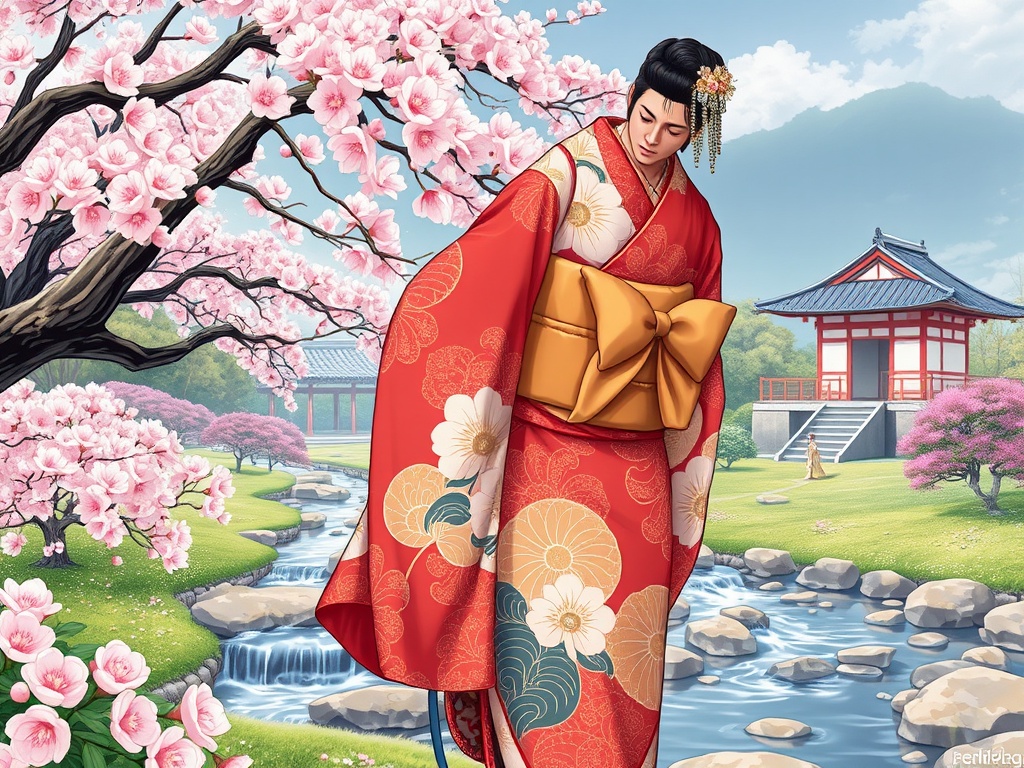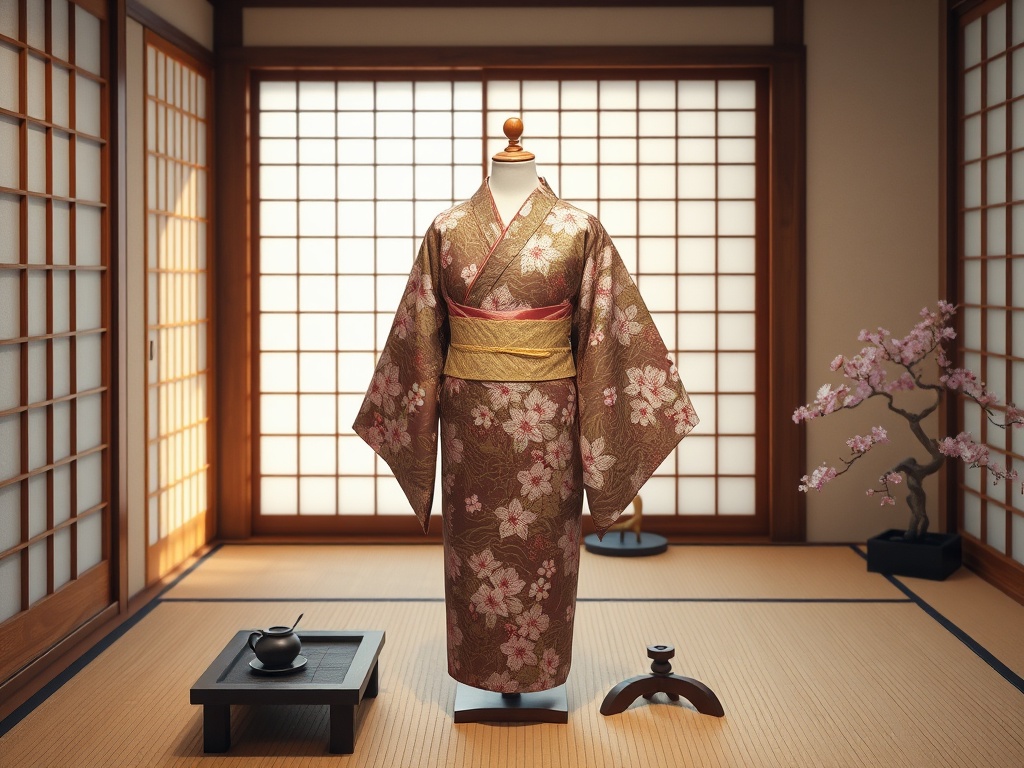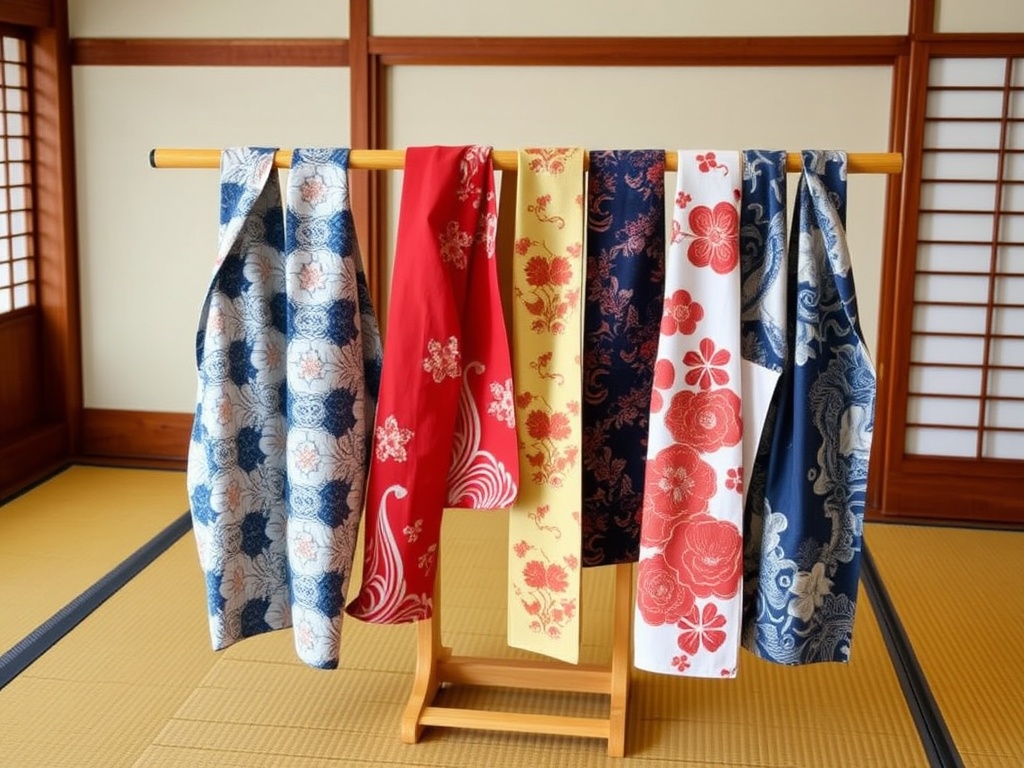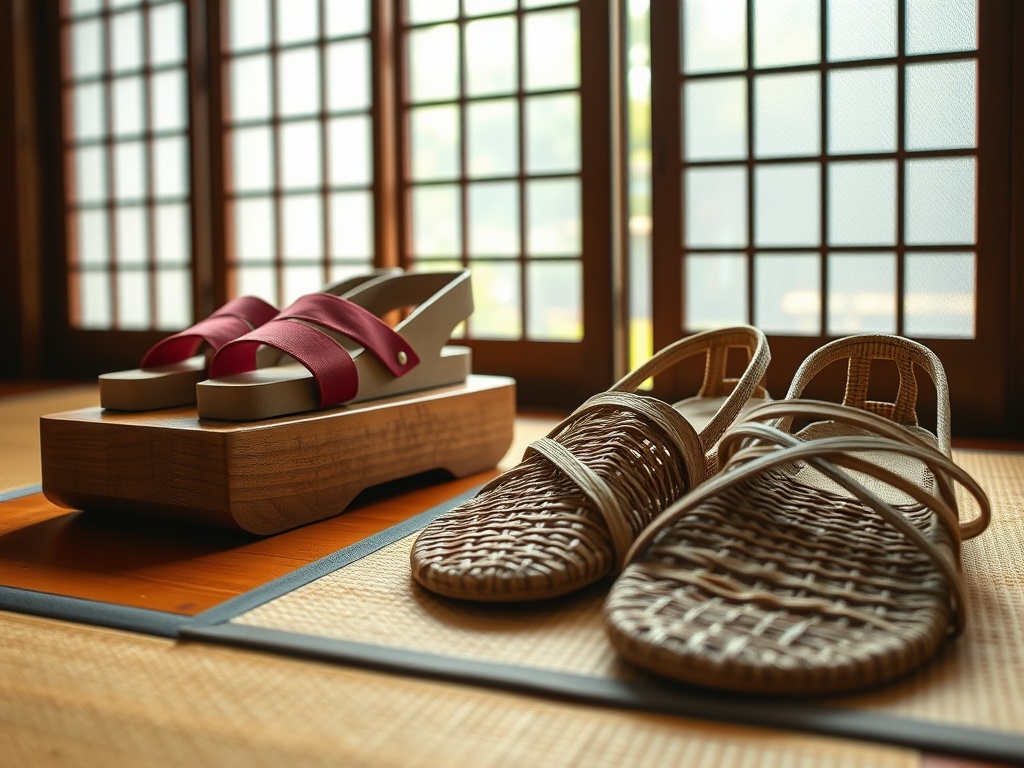Unraveling the Kimono: A Journey Through Japan’s Iconic Garment
Win a Free Trip to Japan!
Experience cherry blossoms and ancient temples
Step into the world of Japanese elegance with the iconic garment that has captured the hearts of many across the globe – the Kimono. More than just clothing, the Kimono is a symbol of Japan’s rich cultural heritage, artistry, and philosophy. Whether you’re a travel enthusiast or a fashion aficionado, understanding the Kimono is essential in appreciating the intricate beauty of Japanese tradition.
The Kimono is a masterclass in layering, with each component playing a critical role in its aesthetic and function. From the naga-juban, the undergarment, to the obi, the ornate sash, each piece contributes to the garment’s overall grace.
Here’s a closer look at the key elements:
- Kimono Robe: The main garment, typically made of silk, featuring long sleeves and a wraparound style.
- Naga-juban: A silk or linen undergarment worn beneath the Kimono to protect the fabric.
- Obi: A decorative belt that keeps the Kimono closed and adds a touch of flair.
- Obi-age and Obi-jime: Accessories used to secure and embellish the obi.
The Kimono’s design is deeply influenced by the seasons, with specific patterns and colors symbolizing different times of the year. This seasonal variation not only reflects nature’s beauty but also conveys a sense of harmony and mindfulness.
Explore the seasonal motifs:
- Spring: Cherry blossoms and soft pastels symbolize renewal and beauty.
- Summer: Bold colors and lighter fabrics to reflect the vibrancy and warmth.
- Autumn: Rich reds and golds capture the essence of fall foliage.
- Winter: Deep blues and whites emulate the serene winter landscape.
Wearing a Kimono is an art form in itself. The process is both ritualistic and transformative, requiring careful attention to detail. It’s a chance to immerse yourself in a tradition that has been passed down through generations, offering a unique window into Japanese culture.
Consider this experience during your visit to Japan:
- Kimono Rentals: Many cities offer rental services where you can choose your Kimono and receive assistance in wearing it properly.
- Kimono Wearing Experiences: Some cultural centers and museums provide workshops on the history and wearing techniques of the Kimono.
The Art of Obi: Discover the Elegance of Traditional Sashes
Embark on a journey through the fascinating world of the Obi, a quintessential element of traditional Japanese attire that transforms the Kimono into a masterpiece of art and fashion. The Obi is not merely a functional accessory; it is a canvas of expression that showcases the wearer’s personality, status, and the occasion’s significance. As you traverse the vibrant streets of Japan, let the Obi guide you through a tapestry of history and artistry.
The Obi, with its intricate designs and luxurious fabrics, serves as a bridge between tradition and modernity. It is meticulously crafted by skilled artisans who pour their expertise and creativity into each piece. The colors, patterns, and materials of the Obi are carefully selected to convey messages and emotions, making each piece a story in itself. Whether adorned with cranes symbolizing longevity or waves representing resilience, the Obi is a silent communicator of the wearer’s story.
The craftsmanship of the Obi is an art passed down through generations, with each artisan adding their touch to this enduring tradition. The process involves weaving, dyeing, and embroidering, creating a piece that is as much a work of art as it is an accessory. The choice of fabric, whether it be silk, cotton, or brocade, adds another layer of elegance, allowing the Obi to shimmer with every movement.
To truly appreciate the Obi, one must experience it firsthand. In Japan, numerous cultural centers offer workshops where you can learn about the history and significance of the Obi, as well as how to tie it. This immersive experience provides a deeper understanding of Japanese culture and aesthetics, allowing you to connect with the traditions that have shaped this iconic garment.
As you wrap the Obi around your waist, feel the transformation as the fabric molds to your form, accentuating the Kimono’s lines and enhancing its beauty. It’s a moment of elegance and grace, a step into the world of Japanese tradition that has been cherished for centuries.
Footsteps of Tradition: Exploring Japanese Geta and Zori Footwear
Embark on a fascinating exploration of Japanese traditional footwear, where the interplay of function and fashion creates an intriguing narrative. The iconic Geta and Zori are not merely footwear; they are an extension of Japan’s cultural tapestry, echoing stories of the past with every step. As you wander through Japan’s streets and cultural hubs, these unique shoes offer a tactile connection to the heritage and aesthetics that have shaped Japanese identity over centuries.
Geta are wooden sandals that have been an integral part of Japanese attire for centuries. Known for their distinctive elevated design, Geta offer both practicality and style. The raised platform not only protects the wearer from muddy streets but also adds an element of rhythm to each stride. The sound of Geta on pavement is a nostalgic melody that transports one to the bustling streets of Edo-period Japan. These shoes are often crafted from lightweight wood, such as paulownia, and are paired with vibrant fabric thongs that infuse a dash of color and personality. Wearing Geta is a reflection of the wearer’s connection to traditional Japanese values and a nod to the country’s rich history.
Zori are another staple of traditional Japanese footwear, offering a more subdued elegance compared to their Geta counterparts. Typically made with straw, cloth, or leather, Zori are known for their flat soles and minimalist design. These sandals are a common choice for formal occasions, harmonizing seamlessly with the sophistication of a Kimono or a Yukata. The simplicity of Zori belies their cultural significance, as they embody the Japanese principle of wabi-sabi, finding beauty in simplicity and imperfection. As you slip into a pair of Zori, you step into a realm where comfort meets tradition, and each movement becomes a tribute to the understated grace of Japanese fashion.
Beyond the Kimono: Dive into the World of Yukata and Jinbei
While the Kimono reigns supreme as the emblem of Japanese tradition, there exists a world of equally enchanting garments that offer a glimpse into the casual and relaxed side of Japanese attire. The Yukata and Jinbei are two such garments, each with its own story and cultural significance, promising an intriguing journey through Japan’s sartorial landscape. As you explore these garments, you’ll uncover the layers of tradition that extend beyond the formal elegance of the Kimono, inviting you to experience the everyday charm of Japanese fashion.
The Yukata is a lightweight, casual garment often worn during the warmer months and at summer festivals. Made from cotton or synthetic fabrics, the Yukata is celebrated for its breathable material and vibrant designs. Unlike the Kimono, the Yukata is less formal, making it a popular choice for festivals, fireworks displays, and visits to onsen (hot springs). Its simplicity allows for ease of wear, yet it retains the grace and style that Japanese clothing is known for.
- Design and Fabric: Typically features colorful floral or geometric patterns.
- Occasions: Perfect for summer festivals, casual outings, and relaxation at hot springs.
- Accessories: Usually paired with an obi sash and geta sandals.
The Jinbei is a traditional Japanese attire that epitomizes comfort and ease. Consisting of a top and shorts or trousers, Jinbei is typically made from cotton or hemp, making it ideal for lounging at home or in casual settings. This garment is particularly favored for its relaxed fit and is a common sight during summer festivals or as nightwear. Jinbei’s understated elegance and practicality have made it a beloved choice for those seeking comfort without forgoing tradition.
Whether you’re strolling through a summer festival or enjoying a quiet evening at a traditional inn, the Jinbei offers a slice of Japanese life that’s both comfortable and culturally rich.
When selecting between a Yukata and a Jinbei, consider the occasion, season, and your personal comfort preferences. Both garments offer a unique way to immerse yourself in Japanese culture, each providing a distinct experience that complements the vibrancy of Japan’s traditions. Embrace the opportunity to wear these garments during your travels, and let them transport you to a world where tradition and contemporary life blend harmoniously.
| Garment | Material | Occasion |
|---|---|---|
| Yukata | Cotton/Synthetic | Festivals, Casual Outings |
| Jinbei | Cotton/Hemp | Lounging, Casual, Nightwear |
The Craftsmanship of Haori: A Look into Japan’s Stylish Coats
Journey into the world of Japanese elegance with the exquisite Haori, an outer garment that adds sophistication and charm to traditional attire. While often overshadowed by the iconic Kimono, the Haori stands out as a symbol of both style and functionality, offering a glimpse into the meticulous artistry that defines Japanese clothing. As you explore Japan, the Haori invites you to delve deeper into the fabric of its culture, where each stitch and seam tells a story of heritage and innovation.
Artistry and Design: The Soul of Haori
At the heart of the Haori’s allure is its artistry. These garments are typically crafted from luxurious materials such as silk, wool, or synthetic blends, each selected for its ability to enhance the beauty of the coat. The Haori’s design is a masterpiece of subtlety and elegance, often featuring intricate patterns and embroidery that reflect Japan’s natural beauty and seasonal changes. From delicate cherry blossoms to majestic cranes, the motifs on a Haori are more than decorative; they are a celebration of life and nature.
Beyond aesthetics, the Haori serves a practical purpose, providing an additional layer of warmth and protection. Its open front design allows it to be worn effortlessly over a Kimono or Yukata, adding versatility to traditional Japanese attire. The Haori embodies the Japanese principle of functional beauty, where elegance is never sacrificed for comfort.
Haori in Modern Japan: Bridging Tradition and Fashion
In today’s Japan, the Haori continues to evolve, bridging the gap between tradition and contemporary fashion. It is not uncommon to see Haori incorporated into modern wardrobes, adding a touch of Japanese sophistication to everyday outfits. Whether worn casually over jeans or paired with a formal ensemble, the Haori’s adaptability makes it a timeless piece of clothing.
Visiting Japan offers a unique opportunity to witness the Haori’s enduring appeal. Many cultural centers and workshops provide insights into the garment’s history and craftsmanship, allowing visitors to appreciate the skill and dedication required to create these stylish coats. Embrace the chance to don a Haori during your travels, and experience firsthand the elegance that has captivated generations.
Samurai Chic: The Timeless Appeal of Hakama Pants
Embark on a captivating journey through the world of Japanese traditional clothing, where the Hakama pants stand as a testament to the elegance and strength that defines the Samurai spirit. These garments, with their wide, flowing legs and structured form, have transcended their warrior origins to become a beloved symbol of Japanese culture. Whether you’re exploring ancient temples or bustling cityscapes, the Hakama offers a unique blend of history and style, inviting you to step into a world where tradition meets modernity.
The Hakama has its roots deeply intertwined with the Samurai, the revered warrior class of feudal Japan. Originally worn as a protective garment during battles, the Hakama has evolved into a symbol of dignity and honor. Its structured design, characterized by its pleats and wide-legged silhouette, reflects the Samurai’s disciplined lifestyle and their dedication to both martial prowess and cultural refinement. Today, wearing a Hakama is more than a fashion choice; it is a nod to the enduring legacy of the Samurai.
In your travels across Japan, you’ll find that the Hakama is not just reserved for martial arts practitioners or ceremonial occasions. It is a garment that seamlessly transitions from the dojo to the dance floor, embodying the spirit of versatility and elegance. Embrace the opportunity to don a Hakama, and feel the transformation as you connect with the strength and grace that have defined Japanese warriors for centuries.
Despite its historical significance, the Hakama has found a place in contemporary fashion, bridging the gap between tradition and modernity. Designers around the world are reimagining this iconic garment, infusing it with modern aesthetics while preserving its timeless appeal. This renaissance has made the Hakama a favorite among fashion-forward individuals who appreciate its unique style and cultural significance.
As you explore Japan’s vibrant fashion scene, you’ll notice that the Hakama is often paired with both traditional tops and modern blouses, creating a distinct look that captures the essence of Japanese style. Whether worn at weddings, festivals, or as part of a daily ensemble, the Hakama is a versatile piece that continues to inspire and captivate fashion enthusiasts worldwide. Let the Hakama guide you on a sartorial journey through Japan’s rich cultural tapestry, where every pleat and fold tells a story of honor and beauty.
Seasonal Splendor: The Role of Traditional Clothing in Japanese Festivals
As the seasons change in Japan, so too does the kaleidoscope of traditional clothing that graces its vibrant festivals. Each festival, with its unique energy and cultural significance, is an opportunity to witness the resplendent beauty of Japanese fashion in its most festive form. From the delicate textures of fabric to the intricate designs that tell tales of nature and folklore, traditional attire becomes a living canvas, celebrating the harmony between humanity and the world around it.
Traditional Japanese clothing, such as the Kimono and Yukata, play a pivotal role in festivals, where they serve as both attire and artistic expression. The choice of fabric and design often reflects the season’s essence, with spring festivals showcasing garments adorned with cherry blossoms, symbolizing renewal and beauty. In contrast, summer celebrations bring out bright, airy Yukata, their lightweight cotton fabrics perfect for the warm weather. These garments, often decorated with motifs of fireworks or goldfish, echo the liveliness of the season.
The use of specific colors and patterns is more than aesthetic; it is a means of storytelling, a tradition passed down through generations. For example, the rich reds and golds of autumn-themed Kimonos capture the fiery hues of fall foliage, while winter festivities feature designs with deep blues and silvers, mirroring the serene beauty of snow-covered landscapes. This harmonious blend of nature and culture is a testament to the Japanese ethos of finding beauty in every moment.
Japanese festivals are a captivating fusion of ancient rituals and modern festivities, with traditional clothing at their heart. During these events, the air is filled with the rhythmic sounds of taiko drums and the captivating aroma of street food, creating an atmosphere that is both celebratory and deeply spiritual. Attendees, clad in Kimonos and Hakama, become part of a living tradition, each garment a silent narrator of Japan’s rich cultural tapestry.
Visiting a festival in Japan offers travelers an immersive experience, allowing them to step into a world where the past and present coexist seamlessly. The sight of men and women in traditional attire, participating in dances and ceremonies, is a visual feast that highlights the enduring appeal of these garments. Whether it’s the elegance of a silk Kimono at a formal event or the casual charm of a Yukata at a summer matsuri, traditional clothing is an integral part of Japan’s festival spirit, offering a window into the country’s soul.
Silk and Symbols: Understanding the Cultural Significance of Japanese Textiles
The rich tapestry of Japanese traditional textiles is a window into the nation’s cultural soul, weaving together history, art, and symbolism. Journey with us through the lush landscapes of Japan’s textile heritage, where the whisper of silk and the vibrancy of colors tell stories that have transcended time. Whether you’re wandering through bustling markets or serene temples, the allure of Japanese textiles is an enchanting experience that beckons you to explore deeper into the fabric of tradition.
Silk, long revered for its luxurious texture and luminous sheen, holds a place of eminence in Japanese culture. This exquisite fabric, often associated with the Kimono, is more than a material; it’s an embodiment of elegance and sophistication. The art of silk production in Japan dates back centuries, with each region boasting its unique techniques and styles. From the intricate patterns of Nishijin-ori in Kyoto to the delicate beauty of Yūzen dyeing, silk textiles are a testament to the meticulous craftsmanship and artistic expression that define Japanese artistry. As you explore Japan, you’ll find that silk is not just reserved for traditional garments but also plays a role in ceremonies and festivals, where it symbolizes purity and celebration.
Japanese textiles are adorned with a myriad of symbols and motifs, each carrying profound meanings and cultural significance. These designs are not merely decorative; they serve as a form of communication, reflecting beliefs, wishes, and the natural world. Common motifs include the chrysanthemum, symbolizing longevity and rejuvenation, and the tortoise, representing wisdom and stability. The artful integration of these symbols into textiles is a skill passed down through generations, imbuing each piece with a story that resonates with the wearer. As you delve into the world of Japanese textiles, pay attention to these motifs, for they are the silent narrators of Japan’s rich cultural narrative, inviting you to discover the hidden meanings woven into every thread.



